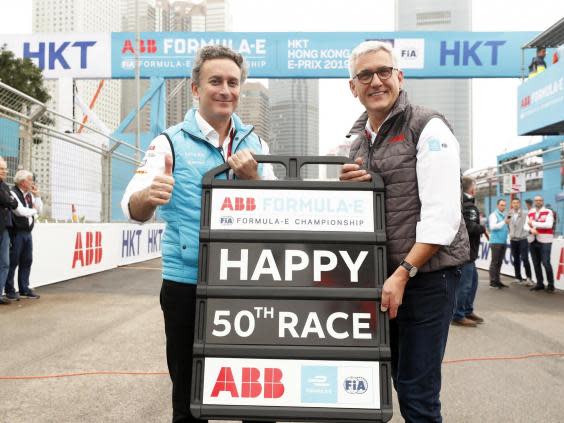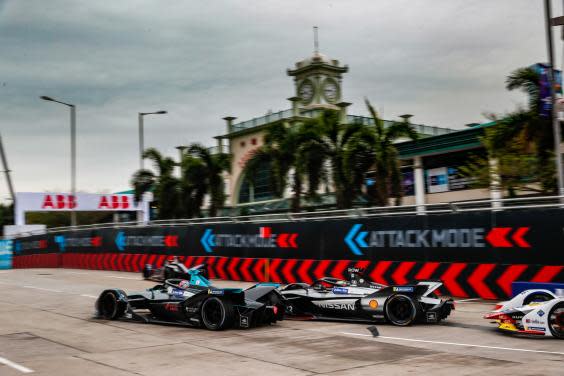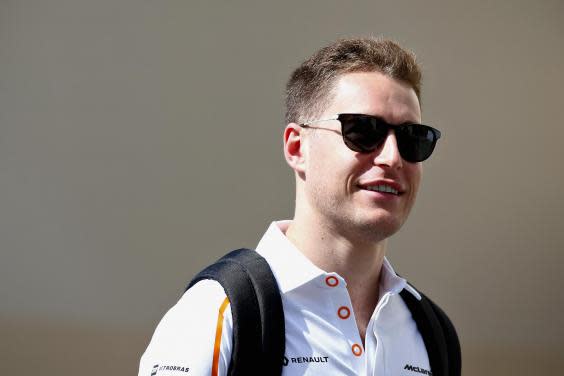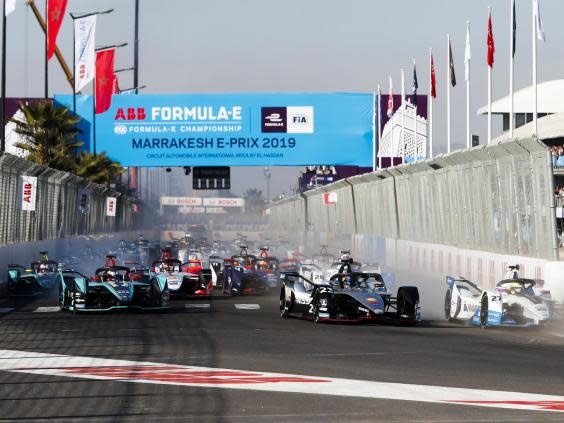The new kid on the block: The rise of Formula E – and what comes next
It’s the skyline that draws you in first. With their heads poking out from the low-hanging mist, Hong Kong’s iron giants stand tall against a backdrop of lush green hills and peaks. At their feet, the city stretches out in all directions. To the north, across the bay, Harbourview Place reaches upwards, its summit lost in the clouds above. To the west and east, the regions of Sheung Wan and Wan Chai, with their bustling fish markets, steep, narrow streets and neon lights.
But, for now, the focus lies elsewhere. The noise is the first giveaway. A high-pitched, whirring screech that sounds like a scalextrics kit on steroids. Then there’s the motion. A blur of metal, carbon fibre and rubber fizzes past, kicking up a fine spray in its wake as a light drizzle falls. Snaking around a 1.86 km circuit, cut from the city’s harbour, this is the Hong Kong E-Prix.
The race, eventually won by Edoardo Mortara, marked an historic moment for the Formula E Championship. As the 50th race of the series – staged in the iconic heart of Hong Kong – this was a stark reminder of just how far the sport has come.
Conceived in 2011, and launched in Beijing in September 2014, the series has grown from strength to strength with each passing year. Initially dismissed in some corners as a Formula 1 pastiche or fad, the sport is slowly but surely establishing itself as its own unique entity.
“We’re not looking to rival or compare with Formula 1,” Stoffel Vandoorne, who races for HWA Racelab after making the switch from F1 to Formula E last year, tells The Independent. “It’s really not the purpose. The whole platform and the way it’s run, the way we engage with fans, it’s very different.”
It’s a view shared by those across the sport – including Susie Wolff, the team principal of Venturi. “I don’t see them [F1 and Formula E] in competition with each other,” she tells The Independent. “They’re two completely different types of racing, and having been in F1 and now in Formula E I stick by that view. We are a different kind of platform and it’s a different way of racing. We’re in the city centres, we bring the racing to the people, it’s a one-day event, it’s a 45-minute race, the cars are not built from scratch. It’s completely different.”
That as much is clear. First and foremost, the sport’s focus on sustainability and its relevance to wider society, in terms of the clean technology it’s developing, helps it to stand apart. There’s no doubt that the electric car is the future – with a number of governments pledging a ban on the sale of petrol and diesel cars in the coming decades – and it’s Formula E which has positioned itself at the forefront of this revolution.
The jump from the Gen 1 to the Gen 2 car has already shown the progress that is being made, with drivers no longer required to change vehicles mid-race. The current Gen 2 battery now has the capacity to last the entire race, and is capable of taking the car up to speeds of 170mph – or, alternatively, charging an iPhone for the next 20 years.
It’s these sort of technological breakthroughs that will allow Formula E to help push forward the development of clean, sustainable energy. In the words of Jerome Hiquet, Formula E’s head of marketing, there is a higher “social purpose” to the sport.
Owner Alejandro Agag himself has made clear the connection between Formula E and the wider world, describing the former as a “laboratory” for today’s car industry which, amid ever-rising climate concerns, is constantly working to modernise and adapt.
Then there’s the sport’s unpredictability. Compared to the dominance enjoyed by a handful of manufacturers and racers in F1, Formula E remains an open book.
This season alone has seen a different winner, under a different manufacturer, for each of the five races. Add into the mix the big names who have made the switch from F1 to Formula E – such as Vandoorne and Felipe Massa – as well as the sport’s own rising stars, and it’s clear to see there’s a vast pool of talent on hand to keep the series from following the F1 duopoly.
“For me, being so long in professional motorsport, the reason I’m here is the drivers it’s attracted,” Gary Paffett, a driver with HWA Racelab, tells The Independent. “The drivers just want competitive motorsport and competitive racing and that’s the reason we’re all here.”
This sense of competition and unpredictability has only been heightened by the rising number of manufacturers joining the sport. With Porsche and Mercedes signing up for the 2019/20 season, this all points to the Championship’s growing reputation. Bluntly put, these brands wouldn’t be throwing their hat into the ring if they didn’t believe the sport was going places. Their presence, taking the total manufacturers in Formula E up to 11, the highest number for any motorsport, will likely usher in a new chapter for the sport as it thrives to broaden its horizons.

Which is where the Formula E’s willingness to innovate comes into the equation. From ‘Attack Mode’, which provides drivers with a power surge by driving through a designated area of the circuit off the racing line, to ‘Fanboost’, which allows voters to award an extra power boost to their favourite driver via social media, the sport isn’t afraid to think differently.
“I think at this moment in terms of innovation, we are maybe younger, taking more risk,” says Hiquet. “We want to continue to create this impression that we have potentially more than other motor sports. We are maybe more a risk-taker and I think that’s part of it.”
Even those early sceptics have come round to Formula E’s way of thinking. “When you talk about the attack mode, if I want to be completely honest, in the beginning I was not convinced about it at all,” Dieter Gass, head of Audi motorsport, tells The Independent. “After having seen it in a few races now, actually I made up my mind and I need to say it’s actually quite a good thing. Obviously it’s going to be different race to race, but today I need to say it’s a very good idea.”
So with its focus on sustainability, unpredictability and innovative outlook, Formula E offers a distinctively different flavour of motorsport – one that was never intended to rival F1’s own product. But what comes next? Is the sport destined to reach a glass ceiling, one that it will never be able to smash through? Or does it hold the potential to carve a new way forward for modern motorsport?
Those inside the series are undoubtedly optimistic of what the future holds.

Indeed, from a British perceptive at least, the BBC’s decision to broadcast every race for the 2018/19 season marked a watershed moment. “Being British, that is something that my wider circle suddenly started talking about,” Wolff says. “Once you get on the BBC and on iPlayer and we’re live this weekend [for the Hong Kong E-Prix], you automatically reach a much wider audience.”
The challenge, now, is pushing forward with this exposure. For Gass, that means looking towards America. “I think we need to potentially get a bit better TV coverage in a few areas, like the US for example where it’s a reasonably dark spot on the map still.”
Still, Formula E is working hard to appeal to the younger, more internet-orientated generation of today. “We have this target of getting to a younger demographic,” says Agag. “We want to get new fans into motorsport, and the problem with motorsport is that the fanbase is growing older.” This is why, then, the sport is making the most of social media and the internet to promote its brand. Press conferences are live streamed on Facebook while the sport has gone into partnership with YouTube to provide race coverage and accompanying content – all with the purpose of targeting younger fans.
Continuing to race in the heart of the globe’s most distinguished cities is equally key in maintaining the sport’s upward trajectory. “We like cities that immediately appeal to people, that people want to go to,” says Agag. “New York, Hong Kong, the big capitals around the world. We want it spread out as far as possible around the world.” Indeed, the announcement earlier this month that Formula E would be returning to London next year was a major coup for the sport, given the exposure this will bring.
Compared to Formula 1, in which fans are often expected to travel significant distances to reach the relevant circuits, Formula E’s commitment to clean energy allows it to bring its experience to a city’s doorstep. “I think the fact that we are going into big cities, getting closer to the fans is very good,” says Vandoorne. “I think if we can go to more cities around the world [then that will help to further promote the sport].”

With Seoul, Auckland and a host of other cities from Europe and South America all in Agag’s sights, there appears to be no end to Formula E’s plans for expansion.
And, of course, there’s the technology itself. Ensuring Formula E remains at the forefront of today’s electric vehicle (EV) revolution will be vital for sustaining it in the long-term. Once it loses its edge in this sense, its unique position in the market comes under threat.
Unsurprisingly, plans for a Gen 3 car are already underway and it is likely to be a bigger game-changer than its predecessor. The Gen 2 car has the equivalent of 335 horsepower in qualifying spec, but if Formula E is to remain relevant to the development of EV technology then that will be increased significantly with Gen 3. According to reports, figures in excess of 650 horsepower are already being discussed.
It’s something Paffett, a former McLaren F1 test driver and two-time DTM champion, would welcome with open arms. “If you can get more power then you can have cars that have a bit more downforce, bit more grip, which is a bit more rewarding to drive,” he says. “So I think that’s where the series should try and target really.”
Agag, and many others within Formula E, have also outlined their desire to The Independent to bring fast charging to the sport – and to EV technology as a whole.
“We’ve done the batteries which is great, a big step forward,” he said. “But the next tech that is going to help the electrification of mobility is fast charging and if we could showcase fast charging in Formula E that would be a great thing – but we have to see if it’s possible. One of the things you need for fast charging is a lot of energy, you need to provide so much power in a really short period of time to all the garages and that’s a challenge.”

And while Hiquet insists such developments will serve the “sport’s narrative”, he believes they will also allow Formula E to continue to fulfil its purpose as “an electric movement for people”.
All those within the sport, right down to the racers, are similarly attuned to this “transfer of technology” – as Agag put it late last year – and how continuing technological developments will help to keep Formula E relevant.
“The fact is that every car of Audi in the future will be electric, and we need to understand which factors are limiting us, which are the best materials and how to develop software to control the engine,” Lucas di Grassi, a racer for Audi, said in January. “This is what we do here. Not only Audi, but everyone. So, this is much more of a commercial development than Formula 1.”
Looking back across the five years since its launch, it’s clear to see the steps forward taken by Formula E and the manner in which it has revolutionised the motorsport landscape. But while the future continues to shine bright, there is still much to be done. The key, now, is refusing to stand still.
“It has a brand, but I think we’ve got to get more mainstream,” says Wolff. “We’ve got to get more people realising what Formula E is and I think that will happen naturally. I certainly feel, being part of this environment, that we are heading in the right direction.”
